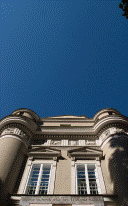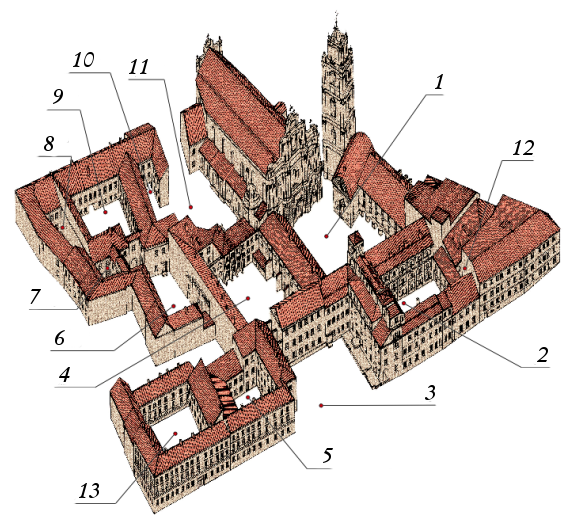
THE VOICE OF INTERNATIONAL LITHUANIA
|
VilNews has its own Google archive! Type a word in the above search box to find any article.
You can also follow us on Facebook. We have two different pages. Click to open and join.
|
Since its establishment in the 16th century, Vilnius University, as integral part of European science and culture has embodied the concept of a classical university and the unity of studies and research.
Vilnius University is an active participant in international scientific and academic activities and boasts many prominent scientists, professors and graduates. Scientific development and the expanding relations with global research centres have contributed to the variety of research and studies at Vilnius University.
We invite you for a walk around the University.
| 1. Grand Courtyard
2. Observatory Courtyard 3. Library Courtyard 4. M. K. Sarbievijus Courtyard 5. M. Daukša Courtyard 6. S. Daukantas Courtyard 7. Arcade Courtyard 8. L. Gucevičius Courtyard 9. A. Mickevičius Courtyard |
10. S. Stanevičius Courtyard
11. K. Sirvydas Courtyard 12. Printing House Courtyard 13. Bursų (Hostel) Courtyard A. Astronomical Observatory B. St. Jonh’s Church C. Library D. Faculty of Philology E. Faculty of History |
F. University bookshop “Littera”
G. Centre of Orientalistics H. Faculty of Philosophy R. Rector’s Office S. Reading Room I. Aula Rectoris – Rector’s hall II. Aula Parva – the Small hall III. P. Smuglevičius hall IV. The Theatre hall |
We also recommend the booklet “Vilnius University 2009”.
History

The University of Vilnius, one of the oldest and most famous establishments of higher education in Eastern and Central Europe, was founded in 1579. Functioning for a long time as the only school of higher learning in Lithuania, it was a preserver of cultural and scientific traditions, and has played a significant part in the cultural life not only of Lithuania, but the neighbouring countries as well. During more than four centuries of its existence, the University of Vilnius has seen periods of growth and decline, revival, and closure. The University is a unique witness to the history of the Lithuanian state.
In 1579, King Stephen Bathory's charter transformed the Jesuit college, founded in 1570, into an establishment of higher education, Academia et Universitas Vilnensis Societatis Jesu, the transformation being confirmed by Pope Gregory XIII. Although being away from other European cultural centres, the University equalled other famous European Universities and had outstanding professors and students, some of who were: the poet Mathias Casimir Sarbievius; the famous professor of rhetoric and philosophy Žygimantas Liauksminas; the author of the first history of Lithuania Albertas Vijūkas-Kojelavičius; professor Martin Smiglecki, whose book “Logics” was very popular in United Kingdom and France, and many others. The first book in the Lithuanian language on the territory of the Great Duchy of Lithuania was published at the University. In 1753, the Astronomical Observatory was set up.
In 1773, the Jesuit order was dissolved in Europe and the University was taken over by the secular authority. After Lithuania was annexed by Russia, the University was renamed into Vilnius Principal School. In 1803, the University received a new statute and the title of the Imperial University of Vilnius. Many famous names were associated with the University at that period: the famous medical men from Vienna Johann Peter Frank and his son Joseph Frank, the historian and public figure Joachim Lelewel, the poets Adam Mickiewicz and Juliusz Slowacki, historian Simonas Daukantas, etc. As a number of students and professors became engaged in the anti–tsarist movement, the University was closed down according to the orders of tsar Nicholas I, and it was not reopened until 1919. Vilnius and its region were then annexed by Poland, and the University functioned under the Polish auspices until 1939 by the name of Stephen Bathory University. Among students of the University at that time was the future Nobel prizewinner Czeslaw Milosz.
In 1939, the University was brought back under the control of Lithuania, but in 1940 after the Soviet occupation it was reorganized according to the Soviet model. In 1943, the University was closed down by the Nazis, and resumed its activities in the autumn of 1944. Though restrained by the Soviet system, Vilnius University grew and gained force. Vilnius University started to free itself from the Soviet ideology in 1988 even before Lithuania regained independence in 1990. The University got back its autonomy and adopted its own statute.
If you want to learn more about the history of Vilnius University, have a look at the publication “Universitas Vilnensis 1579–2004”.
- Bookmark :
- Digg
- del.icio.us
- Stumbleupon
- Redit it
VilNews e-magazine is published in Vilnius, Lithuania. Editor-in-Chief: Mr. Aage Myhre. Inquires to the editors: editor@VilNews.com.
Code of Ethics: See Section 2 – about VilNews. VilNews is not responsible for content on external links/web pages.
HOW TO ADVERTISE IN VILNEWS.
All content is copyrighted © 2011. UAB ‘VilNews’.

 Click on the buttons to open and read each of VilNews' 18 sub-sections
Click on the buttons to open and read each of VilNews' 18 sub-sections 




bcbcvbvcbbgfgfdgg